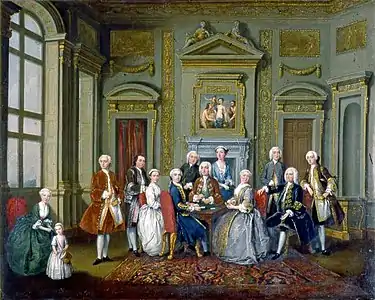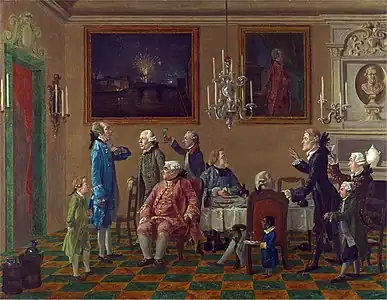John Tylney | |
|---|---|
 a caricature of Earl Tylney | |
| Born | John Child 1712 England |
| Died | 17 September 1784 Naples |
| Nationality | British |
| Education | Christ Church in Oxford |
John Tylney, 2nd Earl Tylney (1712 – 17 September 1784) was an English aristocrat and member of parliament who moved to Italy after a homosexual scandal.[1][2]
Life
| Younger Sons of the Duke of Rutland's Names Act 1734 | |
|---|---|
| Act of Parliament | |
.svg.png.webp) | |
| Long title | An Act for enabling the Two Younger Sons of John Duke of Rutland, by Bridget late Dutchess of Rutland, and their respective Children, Progeny, and Issue, to take and use the Surname of Sutton, pursuant to the Will of Robert Lord Lexington, deceased, and in such Manner as is therein mentioned. |
| Citation | 8 Geo. 2. c. 2 |
| Dates | |
| Royal assent | 24 March 1735 |
Child was baptized on 22 October 1712. He was the third son of Richard Child, 1st Earl Tylney, and Dorothy, daughter of John Glynne of Henley Park, Surrey. Dorothy Glynne's mother was the heiress Dorothy Tylney whose father was Frederick Tylney of Tylney Hall. Due to the inheritance, Richard Child and his sons all adopted the surname of Tylney in 1734, by private Act of Parliament (8 Geo. 2. c. 2).[1]
John Child was educated at Westminster School in 1721 and later at Christ Church in Oxford.[1] At the 1734 general election, his father stood down from his seat at Essex in his favour, but he was not elected.[3] In 1750, John Child, now John Tylney became the Earl of Tylney and inherited Wanstead House, where he lived. At the 1761 general election, he was returned as Member of Parliament for Malmesbury. In February 1764,[4] Tylney was in Florence, and later he settled in Naples.[2]
In 1765, he was a larger seated figure included in a caricature[5] painting by Thomas Patch.[4][6] Patch was another Englishman living abroad and he had left Rome for Florence after he had been banished for a scandal based on his homosexuality.[7]
Tylney died on 17 September 1784 in Naples. His heir was his nephew, James Tylney-Long.[1]
Gallery
 The Tylney Family in the Saloon at Wanstead by Old Nollekens, 1740. The Earl is seated at right, attended by his son John, right; his wife sits at the table opposite 3rd son Lt. Josiah RN, whilst a daughter in blue stands behind. To the left is the infant James Long, with father Sir Robert Long looking on (coll. Fairfax House, York, CT198.327).[8]
The Tylney Family in the Saloon at Wanstead by Old Nollekens, 1740. The Earl is seated at right, attended by his son John, right; his wife sits at the table opposite 3rd son Lt. Josiah RN, whilst a daughter in blue stands behind. To the left is the infant James Long, with father Sir Robert Long looking on (coll. Fairfax House, York, CT198.327).[8] British Gentlemen at Sir Horace Mann's's Home in Florence (circa 1765), including John Tylney, 2nd Earl Tylney, by Thomas Patch; Yale Center for British Art, Paul Mellon Collection[4][6]
British Gentlemen at Sir Horace Mann's's Home in Florence (circa 1765), including John Tylney, 2nd Earl Tylney, by Thomas Patch; Yale Center for British Art, Paul Mellon Collection[4][6]
References
- 1 2 3 4 "TYLNEY, John, 2nd Earl Tylney [I] (1712-84), of Wanstead, Essex". The History of Parliament. Retrieved 1 January 2018.
- 1 2 Roberts, Geraldine (2015). The Angel and the Cad: Love, Loss and Scandal in Regency England. Pan Macmillan. p. 22. ISBN 9781447283539. Retrieved 1 January 2018.
- ↑ "CHILD, Sir Richard, 3rd Bt. (1680-1750), of Wanstead, Essex". History of Parliament Online (1715-1754). Retrieved 24 November 2018.
- 1 2 3 "The Owners of Wanstead Park Part 9: 1750-1784". The Friends of Wanstead Park. 20 November 2012. Retrieved 19 March 2018.
- ↑ Christie's Review of the Season. Hutchinson. 1976.
- 1 2 British Comic Art 1730-1830: From the Yale Center for British Art. University of Missouri-Columbia, Museum of Art and Archaeology. 1988. p. 27. Retrieved 19 March 2018.
- ↑ "Thomas Patch: National Portrait Gallery". npg.org.uk. Retrieved 19 March 2018.
- ↑ Text copied from Richard Child, 1st Earl Tylney, see that page for attribution.